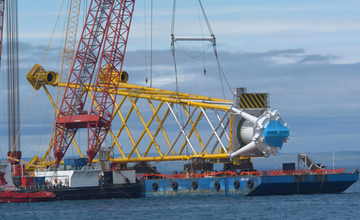Jackets
A jacket is a large welded tubular space structure consisting of vertical or slightly tapered legs connected by lateral placed bracings. Our pipe cutting SPC range can make any cut for legs/nodes or bracings.

As the wind energy market is growing, turbine capacity is growing along with it. Structures to support the increased capacity slowly grow into mega structures. New locations for windfarms lead to new solutions for foundations. This all requires diameter, thickness and size of the wind towers and foundations to change along with the continously changing market. HGG 3D profiling provides you with the software and machines required by this continously developing market to get the highest efficiency possible. Keeping your cost down and your employees safe.
Robotic plasma cutting is a technology that uses robots equipped with plasma torches to cut metal. This technology is often used in the construction of offshore wind farms, as it allows for precise, efficient cutting of the metal components used in the construction of wind turbines. Using robotic plasma cutting in offshore wind construction has several benefits, including increased precision and accuracy, improved safety, and increased productivity. The use of robotics in the construction of offshore wind farms is expected to become more widespread in the coming years as the industry continues to grow.
HGG provides the offshore wind industry with different solutions catered to the specific needs. The three most used HGG machines are in the offshore wind industry are:
HGG provides cutting solutions for tubular and conical shells. Complex connections and multiconnection node geometry can be designed adjusted and profiled on our SPC 1500 – 3000 PT pipe cutting machine to produce structures like; Jackets, Jacket-piles, twisted jacket, Lattice truss structures, Tripods or Tetraspar.
Fabrication of assisting structures in offshore wind are a less visible but essential part of any wind foundation structure. For example transition pieces, utility platforms lower part of the windmill. But also cage and supporting structures for fabrication and logistic supporting structures are ideal to produce on our RPC 1200 Mk3 beam coping machine.
Fabrication of stiffeners for ships, transport barges, caisson, parallelipads, or in general any floating device have similarities with production methods used in shipbuilding industry. Basically any structure made out of steel plate panels that need to be reinforced to gain stiffness to withstand water pressure, can be typically profiled on the PCL600.
A jacket is a large welded tubular space structure consisting of vertical or slightly tapered legs connected by lateral placed bracings. Our pipe cutting SPC range can make any cut for legs/nodes or bracings.

A tripod is a structure on three legs with a minimal number of tubular members (and joints), the central pilar is connected to the legs with often tapered members in general much larger diameters are applied for these structures. The SPC3000 can handle the size and weight for profiling legs pilars and (tapered) members.

Transition Pieces are located in between the (semi) submersed foundation and the windmill tower. Often equipped with boat landings and/or a crane deck. The RPC1200 is the right machine for typical platform structures.

Fabrication of stiffeners for ships, transport barges, caisson, parallelipads, or in general any floating device have similarities with production methods used in shipbuilding industry. Basically any structure made out of steel plate panels that need to be reinforced to gain stiffness to withstand water pressure, can be typically profiled on the PCL600, or the RPC1200.

Supporting Structures, Utility Platforms and for instance Transport Frames are miscellaneous steel structures that support windfarm realization, maintenance and power transfer on shore. Typical design for these structures consist of material that can be processed on our SPC series PCL600 and RPC1200.
